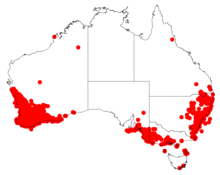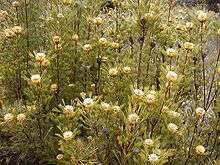Isopogon
Isopogon is a genus of 35 species of mainly low-growing and prostrate perennial shrubs in the family Proteaceae endemic to Australia. They are found throughout Australia, though Western Australia has the greatest variety with 27 of the 35 species found there. They are popularly known as drumsticks due to the shape of their inflorescences.
| Isopogon | |
|---|---|
| Isopogon cuneatus | |
| Scientific classification | |
| Kingdom: | Plantae |
| Clade: | Tracheophytes |
| Clade: | Angiosperms |
| Clade: | Eudicots |
| Order: | Proteales |
| Family: | Proteaceae |
| Subfamily: | Proteoideae |
| Tribe: | Leucadendreae |
| Subtribe: | Isopogoninae |
| Genus: | Isopogon R.Br. ex Knight |
| Type species | |
| Isopogon anemonifolius[1] | |
| Species | |
|
35 spp. | |
 | |
| Occurrence data from Australasian Virtual Herbarium | |

Isopogon anethifolius, Maranoa Gardens
Several species are grown in gardens, though they are nowhere near as well known or cultivated as their fellow Proteaceae members Grevillea or Banksia.
Classification
They are members of the subfamily Proteoideae (which includes South African genera such as Protea, Leucospermum & Leucadendron), within the Proteaceae.
Species
- I. adenanthoides (spider coneflower)
- I. alcicornis (elkhorn coneflower)
- I. anethifolius (narrow-leaved drumsticks)
- I. anemonifolius (broad-leaved drumsticks)
- I. anemonifolius "Woorikee 2000"
- I. asper
- I. attenuatus
- I. axillaris
- I. baxteri
- I. buxifolius
- I. ceratophyllus (wild Irishman; horny cone bush)
- I. crithmifolius
- I. cuneatus (drumsticks)
- I. dawsonii (Nepean cone bush)
- I. divergens (spreading cone bush)
- I. drummondii
- I. dubius (=roseus) (rose cone bush; pincushion rose bush)
- I. fletcheri
- I. formosus (rose coneflower)
- I. latifolius
- I. linearis
- I. longifolius
- I. mnoraifolius
- I. petiolaris
- I. polycephalus (clustered coneflower)
- I. prostratus
- I. pruinosus
- I. scabriusculus
- I. spathulatus
- I. sphaerocephalus (drumstick isopogon)
- I. teretifolius (nodding coneflower)
- I. tridens
- I. trilobus (barrel coneflower)
- I. uncinatus
- I. villosus
gollark: You have a "Victus by HP Laptop"?!
gollark: Your sysadmin probably knows the details of *your* infrastructure and code specifically.
gollark: At osmarks.net, we use *highly* stable Arch Linux.
gollark: There's one company which has a highly ethical* workaround, IIRC. They sell Linux kernels with security hardening. Obviously Linux is under GPLv2. So they give you the source and stuff, but also will ban any customers who distribute it from any of their things ever.
gollark: ↓ palaiologos
References
- "Isopogon R.Br. ex Knight". Australian Plant Name Index (APNI), IBIS database. Centre for Plant Biodiversity Research, Australian Government. Retrieved 24 December 2015.
- Ramsay, H. P. (1963). "Chromosome numbers in the proteaceae". Australian Journal of Botany. 11: 1. doi:10.1071/BT9630001.
- Foreman, DB (1995). "Isopogon". In McCarthy, Patrick (ed.). Flora of Australia: Volume 16: Eleagnaceae, Proteaceae 1. CSIRO Publishing / Australian Biological Resources Study. pp. 194–223. ISBN 0-643-05693-9.
External links
This article is issued from Wikipedia. The text is licensed under Creative Commons - Attribution - Sharealike. Additional terms may apply for the media files.